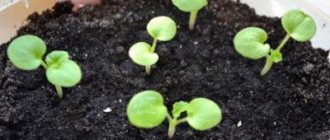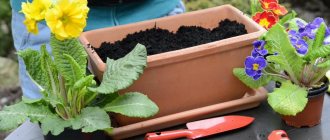Planting and caring for perennial primrose does not require special knowledge and skills. This charming spring flower is considered an unpretentious plant that even an inexperienced gardener can grow. Primrose has hundreds of varieties and often becomes the main decoration of a balcony or terrace. It is used to create beautiful compositions in the garden landscape.
Primrose is not demanding in care and does not create unnecessary trouble for gardeners
Features of growing perennial garden primrose from seeds
Perennial primrose grows and develops well in open ground, blooms profusely, and is grown from seeds. Although this method of reproduction is labor-intensive and time-consuming. Planting material of some perennial varieties requires mandatory stratification. Sowing is demanding in the choice of seeds, which, even under optimal storage conditions, can quickly lose their viability. Regardless of the type of plant, it is important to pay attention to their expiration date. Experienced gardeners claim that the more expensive and newer the variety, the higher the risk of non-germination. When purchasing perennial primrose seeds, you should look at the collection date. If they are more than a year old, then it is likely that the seedlings will not be friendly. Therefore, it is better to collect them yourself, if possible.
Comment! The older the planting material, the longer its germination will take.
The best time for planting primroses is considered to be from February to March. But experienced gardeners often begin sowing seeds as early as January. Such early planting allows you to get a flowering plant in the spring. And if primrose is sowed in April or May, then flowers will appear on it next year.
Spring forcing
For such an agrotechnical technique, the plant is dug up along with a lump of soil and placed in a cold place - +1-3 °C. If you remove the old stems and stems at the beginning of February and replant them in a pot with soil, then on March 8 you can get a flowering bush.
After flowering is completed, the pot should be taken to a cool place - no more than 10 degrees Celsius. After warm weather sets in, the rams can be transplanted into the open sky.
For the operation, it is best to use 2-3 year old plants.
Types and varieties of perennial primrose
The variety of primroses is enormous. Their genus includes 400 species, excluding hybrids and varieties that were developed during the work of breeders. Its lifespan, color scheme, size and shape depend on the type and variety of the plant. There are those that can withstand winter and can withstand frosts down to -40 degrees.
Ordinary
The common primrose (Primula vulgaris) is a popular species among gardeners. It is characterized by the absence of stems, multi-colored colors, and compact sizes (up to 10 cm in height). The perennial blooms from February to March. Grows in pots and flower beds. Famous varieties: “Jacpot”, “Harlequin Bicolor”, “Cobalt Blue”, “Amethyst Ice”.
Common primrose can be grown on a terrace or balcony at temperatures above -5 degrees
Ushkovaya
Primula auricula - found in meadows and calcareous rocks. The leaves of the species are collected in a mundane rosette, located on short petioles. The flowers are bell-shaped, have a pleasant aroma, and appear in April or May. Famous varieties: “Pegasus”, “Auricula”.
The auricular inflorescences smell like apricot
Julia
A variety of perennial primrose Julia (Primula Juliae) prefers to grow near bodies of water. The flowers are single, lilac in color with a yellow spot in the center. The flowering period is from April to June. Suitable varieties for the garden are: “Sylvia”, “Green Lady”.
When growing Julia, you should not overuse nitrogen fertilizers.
Large-flowered
Perennial large-flowered primrose (Primula grandiflorus) is a very popular species among summer residents. Its flowers are voluminous and come in different shades: green, purple and yellow. The most popular variety is “Francesca” with light green flowers, as well as “Selecta”, “Coco”, “Gator Stiletto”.
The flowers of the large-flowered variety are much larger than those of other species
Terry
Perennial double primrose (Terricus) - has flowers of a different palette. The plant is low and frost-resistant. The best varieties of the species are considered to be “Rosella”, “Frost”, “Rosie”.
Terry primrose tolerates Russian winters well
Mealy
Perennial powdery primrose (Primula farinosa) can grow up to 30 cm in height. Blooms with purple-pink buds from May to September. The leaves are mossy underneath and have a characteristic central vein on the surface.
Powdery primrose can be found in Eurasia and South America
Siebold
Siebold's primrose (Primula sieboldii) has elongated leaves and an elongated peduncle up to 30 cm long. It blooms for two months with buds of various flowers. Interesting varieties: Manakura, Carefree.
Sometimes Siebold is painted in two colors with stripes or eyes on the petals
High
High primrose (Primula elatior) grows up to 0.4 m. The buds are two-colored, located on hanging stems, have an orange neck and a yellow border. Based on the species, many hybrids and varieties have been bred: “Max”, “Louis”, “Suzannah”.
In the wild, tall perennial primrose is found in the Urals, the Alps and the Pyrenees
Japanese
Japanese primrose (Primula japonica) has large long leaves (25 cm) and long flowering. The inflorescences of the plant are arranged on stems in several tiers and are colored crimson. Common varieties are Apple Bloss and Alba.
Japanese primrose blooms for about 40 days
Obkonika
The perennial primrose Obconica (Primula obconica) can grow up to 30 cm. It blooms with red, white, pink buds with a green eye. It has beautiful leaves on long petioles.
Obconia reproduces well by seeds
Polyanthus
Perennial polyantha primrose (Primula polyantha) lives on average 2 years. The flowering period lasts from May to June. This species comes in a variety of colors. The buds are purple, orange, yellow and red.
Polyanthus primrose has good winter hardiness and blooms for a long time.
Description of the plant
The international name of this flower is primrose (lat. Primula). The genus Primulaceae, to which primrose belongs, is one of several members of the Primrose family. It contains at least 390 species, most of which grow in temperate climates. These are all herbaceous crops, including both annuals and perennials.
Common primrose (Primula vulgaris) is the most common garden primrose. The height of the plant is 10–30 cm. It is characterized by the presence of a rosette of leaves close to the ground, with a short stem in the center.
Botanical description of the genus Primrose:
- distribution area: temperate zones of western and southern Europe;
- in its natural environment it grows under bushes in deciduous forests, in clearings, roadsides, near railway tracks, in open pastures; in areas rich in humus, sometimes on stony loams;
- flowering: February - March;
- flowers: pale yellow with green veins; 2–4 cm in diameter, grow on thin stems;
- fruit: seed capsule;
- pollinators: insects;
- leaf rosette: basal;
- leaves: 5–25 cm long, 2–6 cm wide, wrinkled, gradually tapering towards the stem, with a jagged edge.
Find out more about the auricular primrose variety.
How to grow perennial primrose from seeds
In addition to propagation by division, perennial primrose can be grown from seeds, although the method is considered more complex and labor-intensive. Seeds are grown both for seedlings and in open ground. In the first case, sowing is carried out starting at the end of January, in the second - before winter.
For planting, use universal soil. Pour it into containers, water it, distribute the planting material on top and gently press it in, moisten it with a spray bottle with water with the addition of a fungicide. Cover the container with a transparent lid and send it to a room with a temperature of +12 to +18 degrees.
After the seedlings emerge, shade from the sun is provided and regular watering is provided. The soil should be moist, but not waterlogged. Also, from the moment the seedlings appear, you should not forget to constantly ventilate the containers; after a pair of true leaves have grown, the lids can be removed from them.
During cultivation, seedlings of perennial primroses need 2-3 pickings. They are planted in open ground when the threat of frost has passed.
Important! Seeds of certain species of perennials require stratification. Before sowing, this point should be clarified.
The plant from seeds blooms the next year
When to sow seeds in open ground
The best time for sowing perennial primrose seeds in open ground is the end of summer, the period after they ripen. With proper care, this planting provides maximum germination.
Sowing plant seeds in the fall, from September to November, is also considered effective. In this case, the young shoots will begin active growth in the spring and, possibly, will bloom in the same year. Some gardeners plant perennial primrose seeds in open ground in the spring, but this method gives the worst results. Sowing is carried out immediately after the snow melts. It is better to do this in a pot dug into the ground. Then they constantly make sure that the surface of the soil in it is not washed away by rain or does not dry out.
Advice! The method of planting seeds in open ground is more suitable for species with large seeds.
How to sow seeds correctly
The perennial shows the best seedlings when planting fresh seeds. This is an important condition when growing crops. Stale planting material germinates slowly and may not produce seedlings at all.
Primrose seeds are small, so there is no need to plant them in the ground. The planting procedure begins by filling the box with soil, after which the material is evenly scattered over it and then moistened with water. If there are few seeds, they can be spread on the surface of the soil with a toothpick dipped in water.
The seeds of the plant are very small, 1 gram contains about 450 pieces
When should primroses be replanted?
On average, these flowers are replanted every 3-4 years.
The first transplant is done 4-5 years after planting primrose, propagated by cuttings or the more popular seed method.
This is done in spring (August) or autumn (early September).
Progress:
- The flowerbed is watered.
- Each bush is carefully dug up (I do not use a large “potato” shovel, which can cut the roots of all the neighboring plants, but a small “children’s” flower shovel).
- The adhering soil is shaken off the roots, after which the root system of each bush is washed in a bucket or basin of water.
- The bushes are divided.
- The cuttings are planted in a new place (necessarily in partial shade or in a shaded area) and watered.
Dividing the bush
Division is a mandatory procedure during transplantation. Therefore, in fact, it is necessary to clean the roots from the soil so thoroughly.
Each bush is divided into 2-3 parts using a knife (for insurance, the knife can be wiped with alcohol - this way it will definitely not introduce bacteria into the cuts). All divisions should have one regeneration point left, from which a new bush will grow. Schematically it looks like this:
To prevent the sections from rotting, they are sprinkled with ash or rubbed with crushed charcoal (or activated) charcoal. Instead, the cuttings can be disinfected with a fungicide.
This procedure rejuvenates the bushes. In addition, planting is a great way to share the beauty of your garden with your neighbor or friends. Finally, in the fall, the cutting can be stuck into a pot and brought into the house - the grateful bush will bloom in your room in winter.
Is it possible to plant primroses in their old place if there are no other free flower beds? Yes, you can. In this case, you simply cut off all excess from the bushes. Return the strongest sections to the ground, and throw away all the weak and thin ones.
Is it possible to touch the bushes during flowering? There are many answers to this question. Some gardeners are afraid to replant flowering primroses, others are not. Personally, I tried it, and nothing bad happened to the bushes. Therefore, I am not against such a transplant.
You can see the procedure for dividing a bush of yard (garden) primroses here:
What if a leaf comes off during this procedure?
If it is an axillary shoot, you can not throw it away, but germinate it, turning it into a full-fledged bush. In addition, the cutting method of propagation is good if your primrose has not yet grown and has not “grown up” to transplantation, but you need to propagate it.
The leaf must have a petiole, a bud, and also part of a shoot.
The leaf blade of such a leaf is cut in half. After this, the cuttings are planted in moist soil (if you are germinating many leaves at once, you can use a wide “brotherly” container). They germinate it in the light (but so that the sun's rays do not fall directly on the leaf), at 16-18 degrees. If necessary, the soil should be lightly sprayed.
When a shoot emerges from the bud and several leaves grow on it, the rooted cutting can be transplanted into a separate small pot (take no more than 9 cm in diameter, that is, it can even be a disposable cup).
In spring, such a plant can already be transplanted into a flowerbed.
Caring for perennial primrose in open ground
Planting and caring for perennial primrose in open ground is not difficult. After the plant has taken root in a permanent place, it is cared for according to the following algorithm:
- Provide moderate watering at least once a week.
- Do not allow a dry crust to form on the ground; loosen the soil regularly.
- Remove weeds and wilted flowers in a timely manner.
- Feed the crop at least twice a month.
- They are transplanted to another place every 4 years, while dividing the bushes.
- Cover plants for the winter with bark, peat, pine branches or dry leaves.
Attention! In order for a perennial primrose to bloom annually, it must be fertilized frequently, and alternate phosphorus and potassium fertilizers.
Preparing soil for seedlings
The soil for growing primrose must be fertile, light, with good moisture and air permeability . You can buy universal soil for flower seedlings or prepare a soil mixture with your own hands at home. If you are attracted to the latter option, you can mix the following ingredients:
- leaf humus (2 parts);
- sand (1 part);
- turf land (1 part).
of perlite or vermiculite to both purchased soil and home-made soil ; they will improve the properties of the soil.
Before planting, it is recommended to prepare the soil a month (or at least several weeks) by disinfection. You can pickle (sprinkle the soil with a solution of potassium permanganate or a solution of Fitosporin), you can calcinate it in the oven (place the soil on a baking sheet, layer - 1.5 cm, leave for half an hour at 90 degrees), steam (place the soil on a sieve over steam for an hour and a half) or freeze (the soil is kept in the cold for ten days, then transferred to a warm place for the same number of days and again taken out into the cold).
Diseases and pests
Sometimes a perennial primrose can get sick or be attacked by harmful insects. Common plant infections include:
- rot of the stem and root collar;
- cucumber mosaic;
- powdery mildew;
- bacterial spot;
- gray mold;
- jaundice;
- rust.
Ramularia cercosporella, a fungus that appears in late spring in the form of brown spots on the leaves, causes enormous harm to perennial primroses. If a disease is detected, the plants should be immediately sprayed with an antifungal drug and the affected leaves should be removed.
As for pests, perennial primrose can become a victim of insects such as:
- aphid;
- fleas;
- spider mite;
- weevil;
- slugs
Attention! Experienced gardeners recommend regularly inspecting the crop for infections and parasites.
In order to prevent illnesses, it is necessary to treat the bushes with Fundazol, Topsin or Bordeaux mixture every spring. In the fall, it is advisable to spray the plants with the insecticide Nitrofen.
The culture is not highly immune to diseases and pests
Common mistakes and recommendations
If you improperly care for perennial primrose, various problems can arise. Some of the mistakes gardeners make include:
- Drying and withering of leaves. Occurs due to lack of moisture and exposure to direct sunlight.
- Poor flowering. Occurs due to nutritional deficiency.
- Root rotting. May occur as a result of watering with cold water.
Among the tips for planting and caring for perennial primrose, the most common are the following:
- It is important to choose the right place for the plant. The location should be in partial shade. It is advisable that the flower bed be well lit in the spring and hidden from direct sunlight in the summer, for example, under deciduous trees.
- The soil should be fertile, loamy, with humus. For the Japanese and mealy species, a peat substrate is required.
- The soil should be constantly moistened; perennial primrose is poorly resistant to drought.
- The crop requires feeding regularly.
Landing
Landing should be carried out according to certain rules. If you do not adhere to them, you can destroy a viable specimen.
Time
The best period for transplanting this flower into open ground is considered to be spring - mid or late May. You can postpone planting until the second half of September, especially for weak specimens that are able to increase the vegetative mass over the summer.
Place
The choice of location depends on what species the gardener is dealing with. Alpine primrose prefers open areas with direct sunlight. In partial shade or shade, these forms will not show bright flowering even with ideal care.
Other taxa prefer partial shade. It is ideal to plant them under trees or bushes, where the ground does not dry out and natural partial shade is formed. It is best to choose an area where shade is established at midday - this will not only prolong flowering, but also preserve the brightly colored petals.
The site must be well drained; prolonged stagnation of water can lead to rotting of the root system.
The soil
For normal growth, the soil must be moisture-absorbing, but loose enough to ensure normal gas exchange in the root system. Clay substrate works well. If it is too heavy, it can be improved by adding the following ingredients (per 1m2):
- 10 liters of coarse sand;
- 2 kg of rotted cow manure;
- 1 kg vermiculite;
- 2 kg of crushed sphagnum.
After adding the additives, the bed is dug up to the depth of a spade bayonet. There is no point in applying additives deeper, since the roots are located in the upper layer of the soil and do not penetrate deep into the ground.
Planting scheme
The distance between neighboring specimens depends on the size of the adult primrose:
- for large varieties – 20-30 cm;
- for compact varieties – 1-15 cm.
You should strive to ensure that there is no open ground between adjacent plants as they grow. The root rosette should be located directly above the substrate; it cannot be immersed in the ground.
Perennial primrose in landscape design
Perennial primrose looks great in almost any corner of the garden and can be combined with other flowers and ornamental shrubs. It is used as a decoration for alpine slides, borders, lawns, ponds, framing alleys and benches. Toothed, auricular and polyantha primroses are best suited for this. The plant is often planted under bushes and trees, along garden paths. The culture feels good in pots, flowerpots and cache-pots, and serves as decor for balconies, gazebos and stairs. Flower beds look beautiful where different species and varieties of perennial primrose grow, with different flowering periods. With this combination, you can admire the bright buds from early spring until the end of summer.
The perennial is considered a good neighbor and does not displace anyone. Primrose's companions are herbs and flowers, which, like her, prefer moderate humidity and diffuse shade. The plant develops well in tandem with astilbe, hosta, fern and dwarf conifers. Many people plant primrose with crocuses, hyacinths, pansies, and complement the composition with evergreens, such as ivy and boxwood. The culture looks good when planted in a diamond pattern, in rows, in a semicircle and around garden statues. In small areas, primrose is planted as a tapeworm on the lawn.
Perennial primrose is an excellent companion that does not interfere with the growth and development of its neighbor











